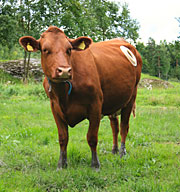- Number 330 |
- February 7, 2011
How now, inside the cow? 30,000 enzymes for biofuel

Cows eat grass—this has been
observed for eons. But now,
through massive-scale DNA
sequencing at DOE's Joint
Genome Institute, Lawrence
Berkeley National Laboratory
scientists have characterized
thousands of genes from
plant-digesting microbes isolated
from the cow rumen for
improvements in biofuels
production.
Cows eat grass—this has been observed for eons. From this fibrous diet consisting mainly of the tough to degrade plant cell wall materials cellulose and hemicellulose, substances of no nutritional value to most animals, ruminants manage to extract all they need to nourish themselves, their progeny and their keepers. And now, the cow, or rather the network of organisms working unseen in the cow’s forestomach or rumen, is providing researchers with vital information that may someday accelerate the large-scale deployment of biofuels. This will offer a window into a major category of microbes that has long resisted the attempts of scientists to grow and study.
Through massive-scale DNA sequencing, researchers at the U.S. Department of Energy (DOE) Joint Genome Institute (JGI), Lawrence Berkeley National Laboratory with support from the Energy Biosciences Institute (EBI), have characterized the genes and genomes of plant-digesting microbes isolated from the cow rumen and reported in a study published January 28 in the journal Science.
http://www.jgi.doe.gov/News/news_11_01_27.html
<http://www.jgi.doe.gov/News/news_11_01_27.html>
[David E. Gilbert, 925.296.5643,
degilbert@lbl.gov]
